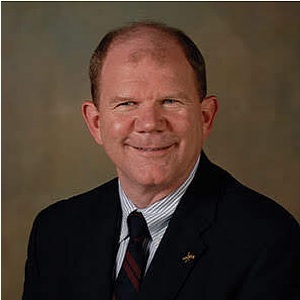Energy Alliance Policy Director Bill Peacock said Texas could solve its power problems as easy as one, two, three.
“The three steps for ensuring a reliable and affordable grid in Texas are eliminating renewable energy subsidies, making renewable generators pay for the costs they impose on the system and stopping the Public Utilities Commission of Texas from manipulating the market,” Peacock told Houston Daily.
But he said that’s not happening, with renewable energy producers continuing to drain resources from the system while being highly unreliable. That’s far from a free market environment, in Peacock's opinion.

Energy Alliance Policy Director Bill Peacock
| linkedin.com/in/bill-peacock-1a12526
“There is nothing 'market' about current incentives for renewables in Texas,” Peacock said. “The $2 billion renewable generators we'll receive this year from federal, state and local governments completely undermine competition in the Texas electricity market.”
That lack of fairness has led to serious problems, including blackouts in February as Winter Storm Uri battered the state and left millions shivering in the cold. More than 150 people died – some estimates say many more – with losses estimated up to $200 billion.
“The PUC, Texas politicians and generators – including renewable generators – should all be held accountable for their role in the blackouts,” Peacock said. “Unfortunately, that is not happening. Instead, Texans will pay billions of dollars through their electricity bills because of the effort to cover up the responsibility of our policymakers.”
Peacock rejected the idea that a thermal generator maintenance schedule could help ensure that Texas consistently has enough grid power.
“Thermal generator maintenance schedules are not the problem in ERCOT,” he said. “Rather, it is the constant intervention in the market by regulators and politicians that is bringing the grid up short.”
Gov. Greg Abbott sent a letter to the PUC, which oversees the Electric Reliability Commission of Texas (ERCOT). PUC Chairman Peter Lake referred to the letter during a July 22 press conference discussing how ERCOT has changed its approach to acquiring and distributing power.
In the letter, Abbott urges the PUC to do four things to bolster Texas electric grid reliability.
First, to change current market incentives (subsidies) to prioritize the development of reliable power with thermal sources.
Second, to make sure that renewable energy companies pay the state back for the costs they took on to deal with the unreliability of renewable energy generation, most notably during winter and summer of 2021.
Third, Abbott urges ERCOT to form a maintenance schedule for all thermal generators to make sure the Texas grid always has enough power.
Finally, to speed up the transmission of electricity from generation to user consumption.
“The objective of these directives is to ensure that all Texans have access to reliable, safe and affordable power, and that this task is achieved in the quickest possible way,” Abbott wrote. “Through clear communication, transparency and implementation of these critical changes, the PUC and ERCOT can regain the public’s trust, restore ERCOT’s status as a leader in innovation and reliability, and ensure Texans have the reliable electric power they expect and deserve.”
Peacock said this is mere rhetoric, not effective leadership.
“Very little that Gov. Abbott, Lt. Gov. Patrick or the PUC is proposing represents real change,” he said. “They are not fixing the problem. They are just making the problem more expensive.”
Austin News reported that Texas electrical grid operators asked residents in June to ration air conditioning and electricity as temperatures rise in the Lone Star State. These requests come in the wake of a warning from the Electric Reliability Council of Texas (ERCOT) that grid unreliability is caused by Texas’ structural inability to produce enough power.
According to the Texas Public Policy Foundation, the February grid crisis in Texas was caused by a variety of renewable-related factors, including decades of multibillion-dollar subsidies for wind and solar that make it difficult for reliable power plants to compete, no requirement for wind and solar to bear any intermittency costs they impose on the rest of the grid, and the inability of scarcity pricing and limited ancillary services to counterbalance the 50% variability of wind and solar reliability when most demanded.
Analysis by TPPF Policy Director Chuck DeVore indicated that subsidies in the form of federal tax credits and state property tax abatements have significantly distorted the electricity market in Texas to the point where “wind generators, some owned by foreign governments, can pay the grid to take their power and still make money.”
Can Texas energy companies speed up the transmission of power from its generation to consumers?
Peacock said it’s a matter of fiscal fairness.
“The best way to reduce congestion on the grid is for generators to pay for the congestion they create,” he said. “Currently, the cost is socialized and Texans foot the bill."
According to the Houston Republic, the February winter storm that battered Texas and left millions of residents without power has left the future of the state's wind energy industry – which provides less than 25% of overall energy in the state – uncertain. The storms exposed the danger of energy policies that make the state too dependent on wind and solar energy. The extreme cold and snow caused some wind turbines to freeze, leading to power outages across the state during a time of overwhelming demand for energy.
As also widely reported, Texas declined to purchase anti-freezing equipment on most wind turbines due to expectations that the climate would expose turbines to freezing conditions.
During the winter storm that plagued Texans with lengthy power outages, Peacock noted that “the more wind and solar you get onto the grid, the more problems you're going to have with reliability.”
He described how the storm not only contributed to increased demand, but it also created weather conditions that made renewable energy generators unable to operate at even their already diminished expected levels.

